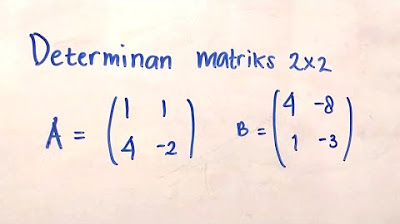Tutorial cara perkalian matriks
Summary
TLDRIn this educational video, the presenter explains matrix multiplication in a simple, step-by-step manner. Beginning with an introduction to matrix dimensions, the video demonstrates how to check if two matrices can be multiplied. The tutorial walks through several examples, showing the multiplication process using rows and columns. Key concepts like matrix order and the multiplication process are clearly illustrated. The video concludes with a recap and encouragement to practice the learned concepts, aiming to make matrix multiplication easy to understand for viewers.
Takeaways
- 😀 Introduction to matrix multiplication tutorial, including an overview of matrix characteristics.
- 😀 The first step in matrix multiplication is ensuring that the number of columns in the first matrix matches the number of rows in the second matrix.
- 😀 The matrix order is essential: rows × columns. For multiplication to be possible, the number of columns in the first matrix must equal the number of rows in the second.
- 😀 Example 1 explains how two matrices with compatible orders (1x2 and 2x1) can be multiplied, resulting in a 1x1 matrix.
- 😀 Example 2 demonstrates how two matrices (2x1 and 1x2) can be multiplied, resulting in a 2x2 matrix.
- 😀 Example 3 shows how two matrices (2x2 and 2x3) can be multiplied, resulting in a 2x3 matrix.
- 😀 When multiplying matrices, each element in the result is obtained by multiplying corresponding row and column elements and summing them.
- 😀 In Example 3, a detailed step-by-step explanation is provided for calculating the elements of the resulting 2x3 matrix.
- 😀 Example 4 illustrates multiplying two matrices (2x3 and 3x2), with a result of a 2x2 matrix, further reinforcing the need for matching dimensions.
- 😀 The tutorial emphasizes the importance of correctly identifying the order of matrices and following the multiplication process step-by-step for accurate results.
Q & A
What is the main topic of the tutorial?
-The main topic of the tutorial is matrix multiplication, where the presenter explains how to multiply matrices and discusses the conditions under which matrices can be multiplied.
How can we determine if two matrices can be multiplied?
-Two matrices can be multiplied if the number of columns in the first matrix is equal to the number of rows in the second matrix. This is crucial for the multiplication to be valid.
What does the 'order' of a matrix refer to?
-The 'order' of a matrix refers to its dimensions, represented by the number of rows and columns. For example, a matrix with 3 rows and 2 columns is said to have the order 3x2.
What happens to the order of the result when two matrices are multiplied?
-The order of the resulting matrix from multiplication is determined by the number of rows of the first matrix and the number of columns of the second matrix. For instance, if a 3x2 matrix is multiplied by a 2x3 matrix, the result will be a 3x3 matrix.
What is the significance of the 'middle number' in matrix multiplication?
-The 'middle number' refers to the number in the center of the matrix order (i.e., the number of columns in the first matrix and rows in the second). If these two numbers are equal, the matrices can be multiplied.
What is the order of the resulting matrix when a 2x3 matrix is multiplied by a 3x2 matrix?
-The resulting matrix will have the order 2x2, which means it will have 2 rows and 2 columns.
How do we calculate the elements of the resulting matrix in multiplication?
-To calculate an element in the resulting matrix, we multiply corresponding elements of the row from the first matrix with the column from the second matrix and then sum the products.
Can you explain the multiplication process with an example from the video?
-In Example 1, when multiplying a 1x2 matrix with a 2x1 matrix, each element of the resulting 1x1 matrix is calculated by multiplying corresponding elements from the row and column and then summing them, which gives a final result of 14.
What happens when two matrices with different orders are multiplied?
-If two matrices do not meet the condition of having the same number of columns in the first matrix and the number of rows in the second matrix, they cannot be multiplied.
What is the order of the result when multiplying a 2x2 matrix with a 2x3 matrix?
-The order of the resulting matrix will be 2x3, as the number of rows of the first matrix and the number of columns of the second matrix determine the dimensions of the result.
Outlines

Этот раздел доступен только подписчикам платных тарифов. Пожалуйста, перейдите на платный тариф для доступа.
Перейти на платный тарифMindmap

Этот раздел доступен только подписчикам платных тарифов. Пожалуйста, перейдите на платный тариф для доступа.
Перейти на платный тарифKeywords

Этот раздел доступен только подписчикам платных тарифов. Пожалуйста, перейдите на платный тариф для доступа.
Перейти на платный тарифHighlights

Этот раздел доступен только подписчикам платных тарифов. Пожалуйста, перейдите на платный тариф для доступа.
Перейти на платный тарифTranscripts

Этот раздел доступен только подписчикам платных тарифов. Пожалуйста, перейдите на платный тариф для доступа.
Перейти на платный тарифПосмотреть больше похожих видео
5.0 / 5 (0 votes)






